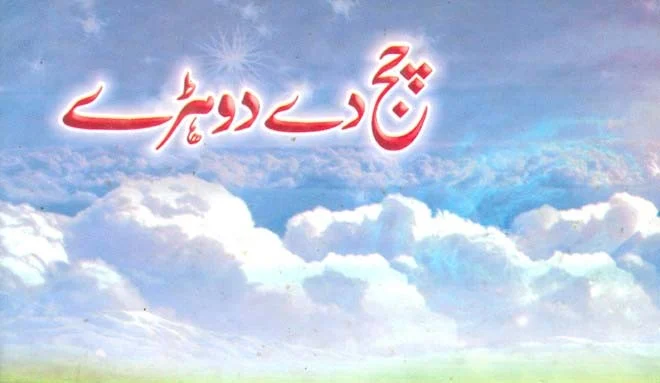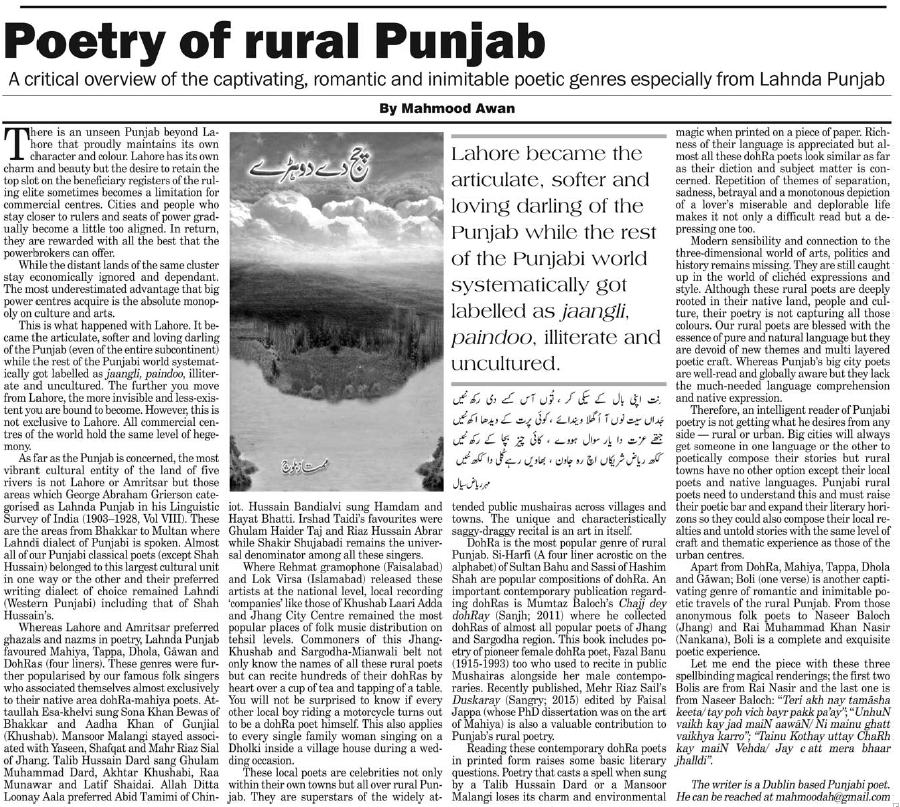Mahmood Awan (The News on Sunday, 31st January 2016)
There is an unseen Punjab beyond Lahore that proudly maintains its own character and colour. Lahore has its own charm and beauty but the desire to retain the top slot on the beneficiary registers of the ruling elite sometimes becomes a limitation for commercial centres. Cities and people who stay closer to rulers and seats of power gradually become a little too aligned. In return, they are rewarded with all the best that the powerbrokers can offer.
While the distant lands of the same cluster stay economically ignored and dependant. The most underestimated advantage that big power centres acquire is the absolute monopoly on culture and arts.
This is what happened with Lahore. It became the articulate, softer and loving darling of the Punjab (even of the entire subcontinent) while the rest of the Punjabi world systematically got labelled as jaangli, paindoo, illiterate and uncultured. The further you move from Lahore, the more invisible and less-existent you are bound to become. However, this is not exclusive to Lahore. All commercial centres of the world hold the same level of hegemony.
As far as the Punjab is concerned, the most vibrant cultural entity of the land of five rivers is not Lahore or Amritsar but those areas which George Abraham Grierson categorised as Lahnda Punjab in his Linguistic Survey of India (1903-1928, Vol VIII). These are the areas from Bhakkar to Multan where Lahndi dialect of Punjabi is spoken. Almost all of our Punjabi classical poets (except Shah Hussain) belonged to this largest cultural unit in one way or the other and their preferred writing dialect of choice remained Lahndi (Western Punjabi) including that of Shah Hussain’s.
Whereas Lahore and Amritsar preferred ghazals and nazms in poetry, Lahnda Punjab favoured Mahiya, Tappa, Dhola, Gãwan and DohRas (four liners). These genres were further popularised by our famous folk singers who associated themselves almost exclusively to their native area dohRa-mahiya poets. Attaullah Esa-khelvi sung Sona Khan Bewas of Bhakkar and Aadha Khan of Gunjial (Khushab). Mansoor Malangi stayed associated with Yaseen, Shafqat and Mahr Riaz Sial of Jhang. Talib Hussain Dard sang Ghulam Muhammad Dard, Akhtar Khushabi, Raa Munawar and Latif Shaidai. Allah Ditta Loonay Aala preferred Abid Tamimi of Chiniot. Hussain Bandialvi sung Hamdam and Hayat Bhatti. Irshad Taidi’s favourites were Ghulam Haider Taj and Riaz Hussain Abrar while Shakir Shujabadi remains the universal denominator among all these singers.
Where Rehmat gramophone (Faisalabad) and Lok Virsa (Islamabad) released these artists at the national level, local recording ‘companies’ like those of Khushab Laari Adda and Jhang City Centre remained the most popular places of folk music distribution on tehsil levels. Commoners of this Jhang-Khushab and Sargodha-Mianwali belt not only know the names of all these rural poets but can recite hundreds of their dohRas by heart over a cup of tea and tapping of a table. You will not be surprised to know if every other local boy riding a motorcycle turns out to be a dohRa poet himself. This also applies to every single family woman singing on a Dholki inside a village house during a wedding occasion.
These local poets are celebrities not only within their own towns but all over rural Punjab. They are superstars of the widely attended public mushairas across villages and towns. The unique and characteristically saggy-draggy recital is an art in itself.
DohRa is the most popular genre of rural Punjab. Si-Harfi (A four liner acrostic on the alphabet) of Sultan Bahu and Sassi of Hashim Shah are popular compositions of dohRa. An important contemporary publication regarding dohRas is Mumtaz Baloch’s Chajj dey dohRay (Sanjh; 2011) where he collected dohRas of almost all popular poets of Jhang and Sargodha region. This book includes poetry of pioneer female dohRa poet, Fazal Banu (1915-1993) too who used to recite in public Mushairas alongside her male contemporaries. Recently published, Mehr Riaz Sail’s Duskaray (Sangry; 2015) edited by Faisal Jappa (whose PhD dissertation was on the art of Mahiya) is also a valuable contribution to Punjab’s rural poetry.
Reading these contemporary dohRa poets in printed form raises some basic literary questions. Poetry that casts a spell when sung by a Talib Hussain Dard or a Mansoor Malangi loses its charm and environmental magic when printed on a piece of paper. Richness of their language is appreciated but almost all these dohRa poets look similar as far as their diction and subject matter is concerned. Repetition of themes of separation, sadness, betrayal and a monotonous depiction of a lover’s miserable and deplorable life makes it not only a difficult read but a depressing one too.
Modern sensibility and connection to the three-dimensional world of arts, politics and history remains missing. They are still caught up in the world of clichéd expressions and style. Although these rural poets are deeply rooted in their native land, people and culture, their poetry is not capturing all those colours. Our rural poets are blessed with the essence of pure and natural language but they are devoid of new themes and multi layered poetic craft. Whereas Punjab’s big city poets are well-read and globally aware but they lack the much-needed language comprehension and native expression.
Therefore, an intelligent reader of Punjabi poetry is not getting what he desires from any side — rural or urban. Big cities will always get someone in one language or the other to poetically compose their stories but rural towns have no other option except their local poets and native languages. Punjabi rural poets need to understand this and must raise their poetic bar and expand their literary horizons so they could also compose their local realties and untold stories with the same level of craft and thematic experience as those of the urban centres.
Apart from DohRa, Mahiya, Tappa, Dhola and Gãwan; Boli (one verse) is another captivating genre of romantic and inimitable poetic travels of the rural Punjab. From those anonymous folk poets to Naseer Baloch (Faisalabad) and Rai Muhammad Khan Nasir (Nankana), Boli is a complete and exquisite poetic experience.
Let me end the piece with these three spellbinding magical renderings; the first two Bolis are from Rai Nasir and the last one is from Naseer Baloch: “Teri akh nay tamãsha keeta/ tay poh vich bayr pakk pa’ay”; “UnhuN vaikh kay jad maiN aawãN/ Ni mainu ghatt vaikhya karro”; “Tainu Kothay uttay ChaRh kay maiN Vehda/ Jay cĥhatt mera bhaar jhalldi”.
Published on 31st January 2016 in The News on Sunday.
https://www.thenews.com.pk/tns/detail/560268-poetry-rural-punjab


